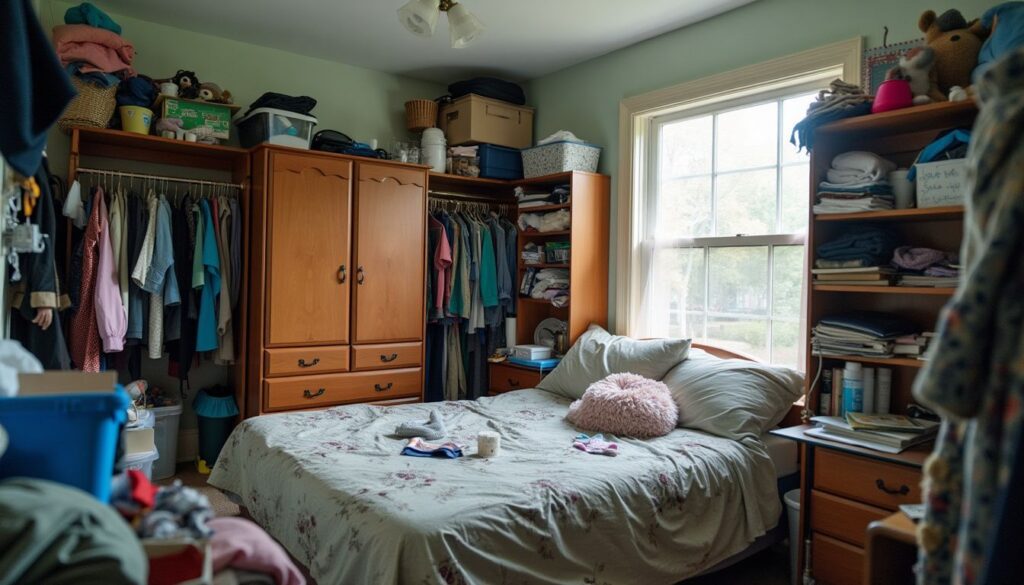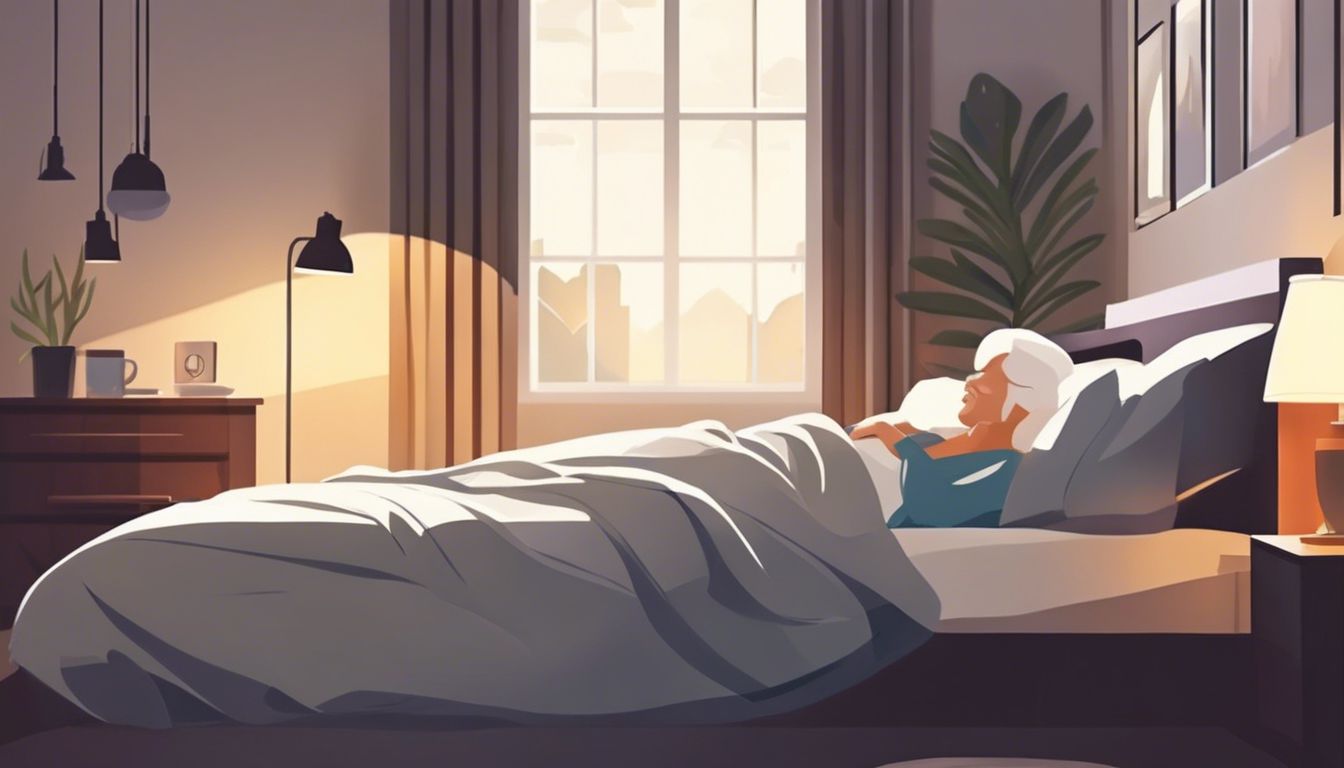Organizing a caregiver’s bedroom can seem tough. One fact is clear: organization helps with time management and stress. This article gives you tips to make the space better and more useful.
Keep reading for helpful advice.
Key Takeaways
- Use furniture that has more than one use and add high shelves to save space.
- Keep important items close to make things easy for caregivers.
- Clear paths help everyone move safely. Make sure there’s enough room for walking aids.
- Choose comfy chairs and soft colors to make the room nice.
- Adjustable beds are good because they reduce strain and allow different resting positions.
Maximizing Space Efficiency

To make the most of a small room, choose furniture that serves more than one purpose. Add shelves and hooks up high to free up floor space.
Utilize multi-functional furniture
Multi-functional furniture saves space and makes life easier for caregivers. Beds with built-in storage keep medical supplies handy. Chairs that convert into step ladders help reach high shelves.
Tables with adjustable heights serve as workspaces or dining areas. This approach keeps essential items within arm’s reach, reducing strain and saving time.
The right furniture can transform a caregiver’s bedroom from cluttered to functional.
Next, think about going up, not out. Vertical storage solutions–like tall shelving units–use less floor space, making more room for movement and assistive devices.
Opt for vertical storage solutions
Opt for shelves that reach up high. This saves floor space. Put things you use a lot on lower shelves. Store less-used items up top. Label bins and boxes to find things fast. It keeps the room tidy and stress low.
Next, make sure everything has its place with these ideas. Use hooks for bags and coats. Add over-the-door organizers for personal hygiene products. This makes caregiving duties easier and helps with aging in place comfortably.
Enhancing Accessibility
Making things easy to reach is key for caregivers. Clear paths and smart arrangement of important stuff make life easier.
Arrange essential items within easy reach
Caregivers need quick access to many things daily. Keeping essential items close saves time and reduces stress.
- Clear the nightstand of non-essential stuff. Only keep must-haves like a glass of water, medications, and tissues.
- Use a small table or shelf for a radio or TV remote. The care recipient can change channels easily.
- Put a phone, laptop, or tablet in an easy-to-grab spot. This helps the caregiver stay connected and manage tasks.
- Keep a personal journal nearby for tracking health and venting frustrations.
- Place puffers or inhalers next to the bed if needed often.
- Have a favorite book within arm’s reach for relaxed reading.
- Add lip balm to the nightstand setup for comfort.
- Use an over-the-bed table for hobbies that match the individual’s interests, like drawing or knitting.
- Make sure there’s good lighting over this hobby space to see clearly without straining eyes.
These steps ensure caregivers have everything needed at hand which aids in self-care and prevents burnout while maintaining privacy and comfort in their bedroom space.
Ensure clear pathways for mobility
Keep floors free from clutter and things that can cause trips. This makes moving around safe for everyone, especially if your loved one needs help walking or uses devices to aid their movement.
Make sure there’s enough room around the bed and through doorways for easy use of wheelchairs or walkers.
Always have a clear path in every direction.
For safety, talk to experts like The Alzheimer’s Society of Canada about how to set up the house right for people with dementia. They suggest making sure there is plenty of space not just in bedrooms but all areas of the home for both care tasks and personal time.
Prioritizing Comfort and Functionality
Making a caregiver’s room comfy and useful is key. Pick chairs that feel good to sit in and use lights and colors that make the space calm.
Select ergonomic furniture designs
Choose chairs and desks that support the body well. This helps to keep away caregiver burnout. Good furniture fits the user’s needs for comfort and health. For example, chairs with adjustable heights are great.
They help in keeping feet flat on the floor and back straight.
Next, think about colors and lights in the room.
Incorporate calming colors and lighting
Calming colors and gentle lights can make a caregiver’s bedroom more relaxing. Soft blue, green, or lavender on the walls help calm the mind. Bright lights are not good for rest. Use lamps with dimmer switches instead.
This way, caregivers can adjust the light for reading or resting without getting up.
Add an over-the-bed table for hobbies that need light. Make sure lamps are easy to reach from bed. This setup supports mental well-being by creating a peaceful space. It also helps in managing tasks like e-signing prescriptions for pharmacies right from their room using a smartphone or tablet.
Benefits of Adjustable Beds for Caregivers
Moving from calming colors and lighting, adjustable beds come into play. These beds boost comfort and make tasks easier for caregivers. They can change the bed’s position to help with moving or caring for someone.
This means less strain on the caregiver’s body during transfers or when reaching out to give medication.
Adjustable beds have features like over-the-bed tables for hobbies. This allows those in elder care to keep doing what they love without much movement. For visitors, adding comfortable seating near the bed creates a welcoming space.
Caregivers find these beds useful as they support better sleep and reduce back pain by adjusting positions easily.
Conclusion
Organizing a caregiver’s bedroom enhances the efficiency of daily tasks. Opt for multifunctional furniture and vertical shelving. Maintain clear access to essential items and keep movement areas unobstructed.
Prioritize comfort in choosing chairs and beds for usability. Adjustable beds serve as a relief point after eventful days. Such a setup benefits caregivers by providing swift access to items like medication management systems and emergency information, thereby reducing stress and improving care effectiveness.
For more insights on enhancing your rest and recovery periods, explore our detailed guide on the benefits of adjustable beds for caregivers.
FAQs
1. What are some tips for organizing a caregiver’s bedroom in an assisted living facility?
Organizing a caregiver’s bedroom involves medication management, planning physical activities, and maintaining mental health. Using apps like Google Calendar can help keep track of tasks and appointments.
2. How can technology assist caregivers in their duties?
Technology plays a key role in caregiving today. Caretakers can use pharmacy apps on Android devices to manage medications and consent forms, while calendars help with scheduling long-term care needs.
3. Can expenses related to the organization of a caregiver’s room be tax-deductible?
Yes, certain expenses related to caregiving may be tax deductible under consumer protection laws…but it depends on individual circumstances and privacy policies.
4. How do personal loans factor into organizing a caregiver’s room?
Personal loans could cover large lump sum costs associated with setting up an efficient space for caregivers at assisted living facilities…including furniture or equipment purchases.
5. Are there any legal documents that need consideration when arranging a caregiver’s bedroom?
Yes! Advance directives should always be considered when organizing such spaces…they ensure that the patient’s wishes regarding healthcare are respected if they cannot communicate them personally.









